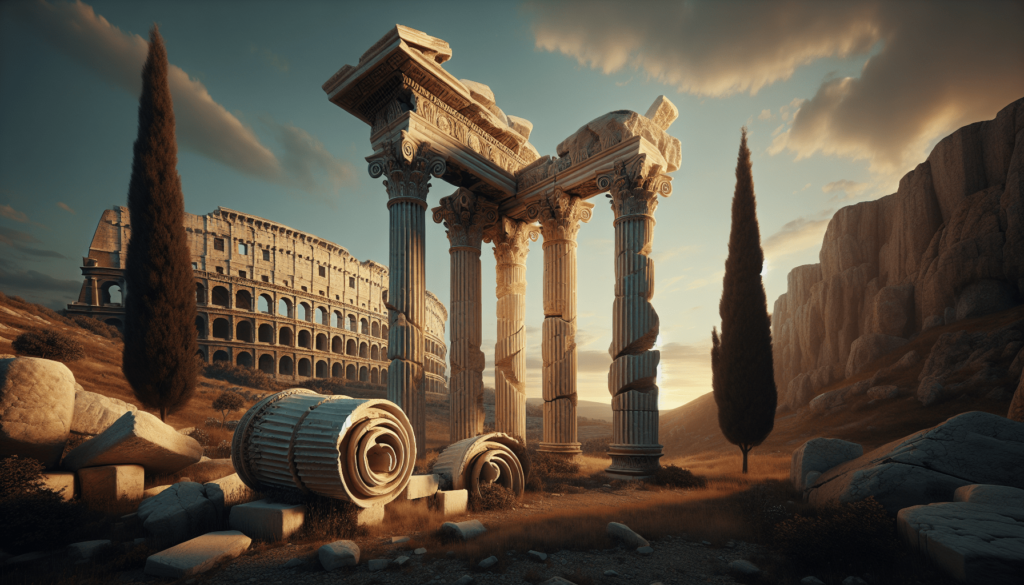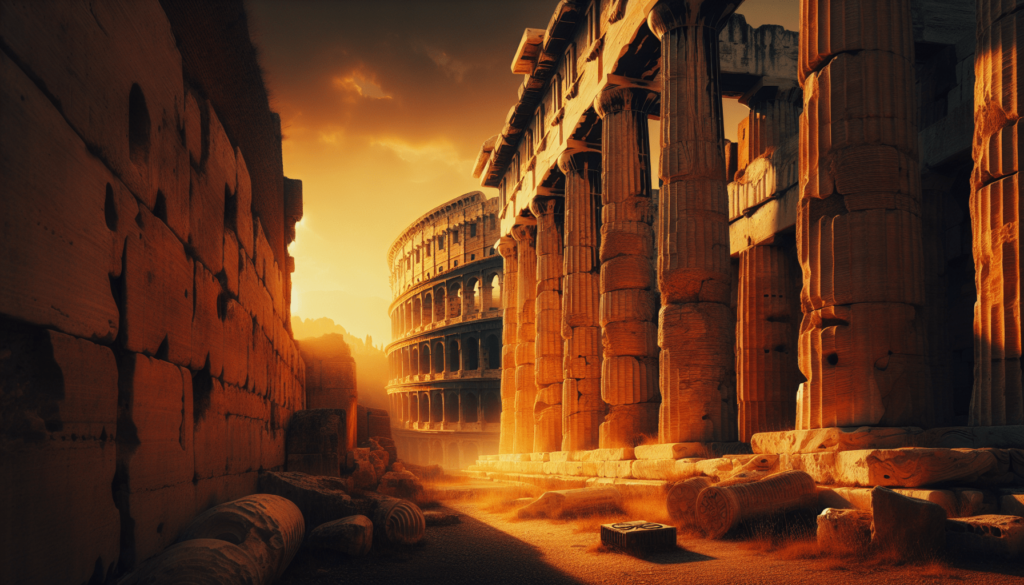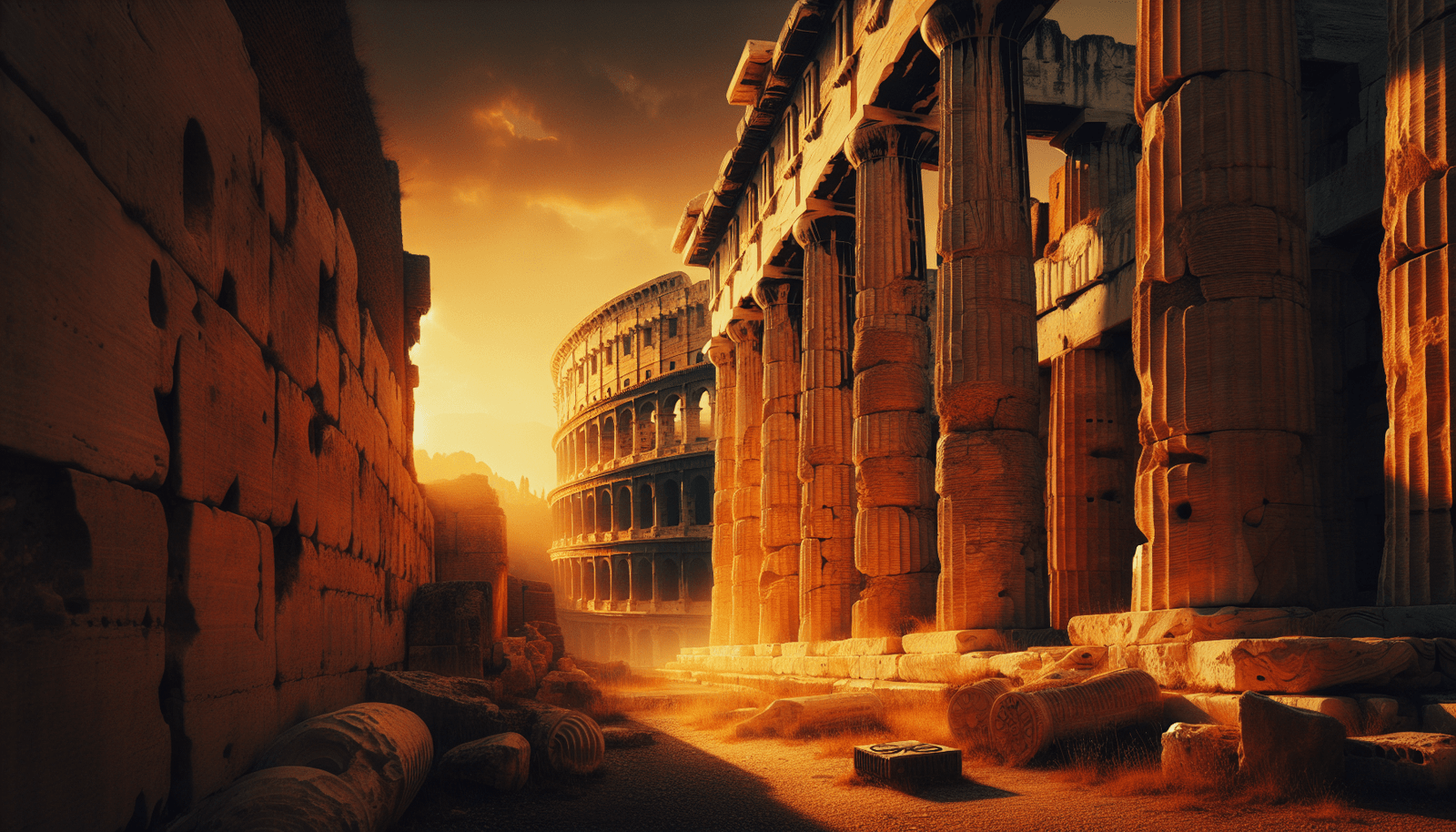Imagine stepping back in time as you wander through the ancient ruins of Greece and Rome. From the iconic Parthenon in Athens to the awe-inspiring Colosseum in Rome, these historic sites transport you to a world long gone, where empires once rose and fell, leaving behind incredible architectural marvels. As you walk among the ruins, you can’t help but feel a sense of wonder and admiration for the craftsmanship and ingenuity of the people who built these structures centuries ago. Join us as we embark on a journey to uncover the secrets of these fascinating ancient ruins and unravel the stories they hold.
Greece
Greece, a country rich in ancient history and majestic ruins, offers an unforgettable journey back in time. One of the most iconic sites in Greece is the Acropolis of Athens. This ancient citadel, perched atop a rocky hill, showcases magnificent examples of Greek architecture, including the breathtaking Parthenon. As you stroll among these ruins, you can almost hear the whispers of the past and envision the ancient Greeks going about their daily lives.
Another must-visit destination in Greece is Delphi, the site of the famous oracle. Delphi was once considered the center of the world and a pilgrimage site for ancient Greeks seeking the wisdom of the oracle. Today, visitors can explore the remains of the Temple of Apollo and the ancient theater, which hosted grand performances during ancient times.
Olympia, the birthplace of the Olympic Games, is another fascinating ancient ruin in Greece. Here, you can walk in the footsteps of ancient athletes and imagine the excitement and glory of the Olympic Games. The ruins of the Temple of Zeus, where the renowned statue of Zeus once stood, still evoke a sense of awe and wonder.
Mycenae, an ancient city fortified with massive stone walls, offers a glimpse into the once powerful Mycenaean civilization. The Lion Gate, adorned with two stone lions, stands as a testament to the grandeur of this ancient civilization. Exploring the tombs, such as the Treasury of Atreus, gives you a glimpse into the rich burial customs and artistic achievements of the Mycenaeans.
Lastly, Knossos on the island of Crete takes you to the heart of the Minoan civilization. The palace complex, with its intricate frescoes and labyrinthine layout, provides valuable insights into the ancient Minoan culture. Strolling through the ruins, you can almost imagine the majestic halls bustling with vibrant activities.
Rome
As you move from Greece to Italy, Rome, the eternal city, awaits with its own array of ancient ruins and historical treasures. The Colosseum, a true icon of Rome, offers a glimpse into the grand spectacles of gladiatorial combat and public performances that once captivated the Roman populace. As you stand beneath the towering arches and peer into the arena, you can almost hear the echoes of the roaring crowd.
The Roman Forum, a bustling center of political and social life in ancient Rome, reveals the remnants of magnificent temples, government buildings, and public squares. Here, you can stand where great Roman leaders once delivered their speeches and witness the remnants of opulent structures such as the Temple of Saturn and the Arch of Titus.
The Pantheon, a marvel of ancient Roman architecture, showcases the ingenuity and grandeur of the Roman Empire. The perfectly preserved dome, with its oculus allowing sunlight to stream in, is a testament to Roman engineering prowess. Walking through the vast interior, you can admire the beautiful marble columns and ornate detailing.
The ancient city of Pompeii, frozen in time by the eruption of Mount Vesuvius in 79 AD, offers an incredibly unique and haunting experience. As you explore the remarkably preserved streets and buildings, you can glimpse into the daily lives of the Roman citizens who once called Pompeii home. From the lavish houses with intricate frescoes to the bustling marketplaces, Pompeii offers a fascinating snapshot of Roman life.
The Forum of Trajan, a testament to the grandeur of the Roman Empire, showcases some of the finest examples of Roman architecture and engineering. The towering column of Trajan, adorned with intricate bas-reliefs, stands as a monument to the military conquests of the Emperor Trajan. Exploring the ruins of the forum, you can marvel at the remains of grandiose structures and gain insight into the power and influence of ancient Rome.

Comparing Greece and Rome
When comparing the ancient ruins of Greece and Rome, several key aspects stand out.
Architecture
Both Greece and Rome were known for their architectural achievements, but with distinct differences. Greek architecture focused on symmetry and harmony, with iconic structures such as the Parthenon showcasing the beauty of the Doric and Ionic orders. Roman architecture, on the other hand, was more concerned with grandeur and imposing scale, as evident in the massive arches and domes of buildings like the Colosseum and the Pantheon.
Religion and Mythology
In both Greece and Rome, religion and mythology played a significant role in daily life. In Greece, the gods and goddesses of Mount Olympus were worshipped through elaborate ceremonies and rituals, and their myths were passed down through generations. In Rome, the pantheon of gods resembled the Greek gods but embraced a more practical approach, with each god associated with specific attributes and responsibilities.
Government and Democracy
Greece is often credited with the birth of democracy, with its city-states governed by elected officials and citizen participation. Athens, in particular, was known for its democratic system and the assembly where citizens discussed and voted on important matters. In contrast, Rome was a republic, with a system of elected representatives and a strong emphasis on law and order.
Art and Literature
Both Greece and Rome were renowned for their contributions to art and literature. Greek art celebrated the human form, with sculptures displaying a sense of balance and idealized beauty. Greek literature, epitomized by works like Homer’s “Iliad” and “Odyssey,” explored themes of heroism and the human condition. Roman art and literature, influenced by the Greeks, took on a more practical and realistic approach, with a focus on portraiture and the achievements of the Roman Empire.
Daily Life
Daily life in ancient Greece and Rome revolved around the family, social customs, and community activities. In Greece, the polis or city-state was the center of life, with citizens engaging in activities such as politics, trade, and cultural gatherings. In Rome, family and social hierarchy played a significant role, with a strong emphasis on duty and honor. Both civilizations valued education and embraced sports and entertainment as integral parts of daily life.
Tips for Exploring Ancient Ruins
When embarking on a journey to explore ancient ruins, there are several tips to make the most of your experience.
Research and Plan
Before visiting ancient ruins, it is essential to conduct thorough research and plan your itinerary. Familiarize yourself with the historical significance of each site and determine the best time to visit, taking into account factors such as weather and tourist crowds. This preparation will ensure a more enjoyable and meaningful experience.
Wear Comfortable Clothing and Shoes
Exploring ancient ruins often involves walking long distances and navigating uneven terrain. It is crucial to wear comfortable clothing and sturdy shoes that can withstand extended periods of walking. Additionally, consider bringing a hat and sunscreen to protect yourself from the sun’s rays, especially during summer months.
Stay Hydrated and Bring Snacks
Exploring ancient ruins can be physically demanding, so it is essential to stay hydrated throughout your visit. Carry a water bottle and refill it whenever possible. Consider bringing lightweight snacks to keep your energy levels up during long walks and exploration.
Use a Guide or Audio Tour
To fully appreciate the historical and cultural significance of ancient ruins, consider using a guide or an audio tour. These resources provide valuable insights and explanations, enriching your understanding of the sites you visit. Guides can offer expert knowledge and answer questions, while audio tours allow you to explore at your own pace.
Respect the Sites and Follow Rules
When visiting ancient ruins, it is crucial to respect the sites and follow any rules or guidelines in place. Do not touch or remove any artifacts, as they are valuable pieces of history. Additionally, be mindful of your behavior and avoid littering or causing any damage to the sites. By treating the ancient ruins with respect, you contribute to their preservation for future generations to enjoy.

Preservation Efforts
Preserving ancient ruins is of utmost importance to safeguard cultural heritage and learn from the past. Several initiatives and projects are dedicated to preserving and restoring these valuable historical sites.
UNESCO World Heritage Sites
Many of the ancient ruins in both Greece and Rome have been designated as UNESCO World Heritage Sites. These sites, recognized for their outstanding universal value, benefit from international protection and support. The UNESCO designation helps raise awareness about the importance of preservation and encourages responsible tourism.
Archaeological Excavations
Archaeological excavations play a vital role in uncovering and preserving ancient ruins. These scientific investigations carefully uncover layers of history and provide valuable insights into past civilizations. Through meticulous excavation methods and documentation, archaeologists piece together the puzzle of the past and ensure the preservation of artifacts and structures.
Conservation and Restoration Projects
Preservation efforts often involve conservation and restoration projects, aimed at maintaining and repairing ancient ruins. These projects require specialized knowledge and techniques to ensure that the integrity and authenticity of the sites are preserved. This careful restoration work allows visitors to experience the ruins as they were intended to be seen, while also protecting them for future generations.
Museum Exhibitions
Museums play a crucial role in preserving and displaying ancient artifacts and relics from Greece and Rome. These institutions adhere to strict conservation practices to ensure the longevity of the displayed objects. Museum exhibitions provide an opportunity to immerse oneself in the ancient world, learning about the history and significance of the artifacts while protecting them from the damaging effects of exposure.
Ancient Ruins as Tourist Attractions
Ancient ruins have become popular tourist attractions, drawing visitors from around the world. While there are undeniable benefits to tourism, it also comes with its challenges.
Tourism Impact
Tourism plays a significant role in the economic development of countries with ancient ruins. It provides a source of revenue, job opportunities, and infrastructure development. However, the influx of tourists can also place a strain on the fragile archaeological sites, causing wear and tear, erosion, and increased pollution.
Economic Benefits
Tourism centered around ancient ruins brings economic benefits to local communities. Visitors contribute to the local economy through spending on accommodations, dining, transportation, and souvenirs. This economic infusion can lead to increased standards of living and improved infrastructure in the surrounding areas.
Cultural Exchange
Visiting ancient ruins facilitates cultural exchange between visitors and locals. It allows people to learn about different cultures, traditions, and historical narratives. Interacting with locals, listening to their stories, and experiencing their way of life fosters mutual understanding and respect.
Challenges and Overcrowding
The popularity of ancient ruins as tourist destinations has led to overcrowding, especially during peak tourist seasons. This overcrowding can diminish the immersive experience and create challenges in preserving the sites. Long queues, restricted access, and limited viewing areas can hinder the quality of the visit and the ability to fully appreciate the ruins.
Sustainable Tourism
To address the challenges of overcrowding and minimize the negative impacts of tourism, sustainable tourism practices are being implemented. These practices aim to strike a balance between preserving the integrity of the ancient ruins and providing a positive experience for visitors. Measures such as visitor quotas, timed entry tickets, and promoting responsible behavior help ensure the long-term sustainability of these precious historical sites.
The Significance of Ancient Ruins
The ancient ruins of Greece and Rome hold immense historical, cultural, and educational significance, transcending time and connecting us to our past.
Historical Importance
Ancient ruins serve as tangible links to the past, allowing us to uncover and understand the historical events, beliefs, and customs of ancient civilizations. They provide insight into the rise and fall of empires, the achievements and struggles of past societies, and the evolution of human civilization.
Preserving Cultural Heritage
Ancient ruins represent a nation’s cultural heritage, reminding us of the rich tapestry of human history. They are a testament to the artistic, architectural, and technological achievements of the past. Preserving these remains ensures that future generations can learn from and appreciate the cultural legacy of ancient civilizations.
Learning and Education
Visiting ancient ruins offers a unique educational opportunity, bringing history to life. Exploring these sites allows us to engage with the past in a tangible way, deepening our understanding of historical events, cultural practices, and societal dynamics. Ancient ruins become classrooms, where we can learn from the successes and failures of civilizations that came before us.
Inspiring Art and Literature
The ancient ruins of Greece and Rome have inspired countless artists, writers, and thinkers throughout history. From the Renaissance to the present day, these ruins have served as muses, sparking creativity and influencing artistic and literary masterpieces. The grandeur of the ancient world continues to captivate and inspire us, fostering the creation of new works.
Connecting Past and Present
By exploring ancient ruins, we bridge the gap between past and present. We gain a greater appreciation for the accomplishments of our ancestors and recognize that our modern world is built on the foundations laid by these ancient civilizations. Ancient ruins remind us of our shared humanity and serve as a powerful reminder of the enduring impact of the past on our present.
Popular Tours and Itineraries
To fully immerse yourself in the ancient ruins of Greece and Rome, several popular tours and itineraries are available.
Ancient Greece Tour
An Ancient Greece tour typically includes visits to the Acropolis of Athens, Delphi, Olympia, Mycenae, and Knossos. This itinerary allows you to explore the diverse ancient ruins across mainland Greece and Crete, experiencing the rich history and cultural heritage of the Greek civilization.
Ancient Rome Tour
An Ancient Rome tour focuses on the ruins in the eternal city, including the Colosseum, Roman Forum, Pantheon, Pompeii, and Forum of Trajan. This itinerary allows you to delve into the grandeur of ancient Rome, witnessing firsthand the architectural marvels and historical significance of the Roman Empire.
Combined Greece and Rome Tour
For a comprehensive exploration of both ancient Greece and Rome, combined tours are available. These tours offer a seamless itinerary that allows you to experience the highlights of both civilizations, from the Parthenon in Athens to the Colosseum in Rome. This combined tour gives you a deeper understanding of the interconnectedness of the ancient Greek and Roman worlds.
Customizable Tour Options
Many tour operators offer customizable options, allowing you to tailor your itinerary based on your preferences and interests. Whether you want to spend more time exploring specific ruins, focus on a particular aspect of ancient history, or include additional destinations, these customizable tour options offer flexibility and personalization.
The Future of Ancient Ruin Exploration
As technology advances and new discoveries are made, the future of ancient ruin exploration holds exciting possibilities.
Technological Advancements
Technological advancements, such as drones and 3D imaging, are revolutionizing the way we explore ancient ruins. Drones provide aerial views and detailed mapping, enabling archaeologists to uncover hidden features and gain a broader perspective. 3D imaging and virtual reality allow for immersive experiences, bringing the ancient ruins to life in a whole new way.
New Discoveries
Archaeological research continues to unveil new discoveries and shed light on our understanding of ancient civilizations. As new sites are excavated and existing ones are further explored, our knowledge of the past expands, offering fresh insights into the lives of those who came before us.
Virtual Reality and Digital Replicas
Virtual reality and digital replicas provide opportunities for people around the world to explore ancient ruins without physically being there. Through virtual tours and interactive experiences, individuals can immerse themselves in the ancient world, gaining a deeper understanding of the architecture, art, and history of these ruins.
Collaborative Research Projects
Collaborative research projects, involving experts from various fields, are becoming more common in the study of ancient ruins. By combining archaeological knowledge, technological expertise, and historical understanding, these projects enhance our understanding of the past and contribute to the preservation and interpretation of ancient ruins.
Conclusion
Exploring the ancient ruins of Greece and Rome is a truly captivating experience. From the grandeur of the Acropolis of Athens to the haunting ruins of Pompeii, these ancient sites offer a glimpse into the rich history and cultural heritage of past civilizations. The enduring fascination with ancient ruins stems from their historical importance, ability to preserve cultural heritage, educational value, and their inspiration for art and literature. As we explore these ancient ruins, we connect with the past, gaining a deeper understanding of our shared human history. Whether you embark on a guided tour or venture out on your own, the timeless beauty and unforgettable experiences found within these ancient ruins will leave an indelible mark on your journey.

